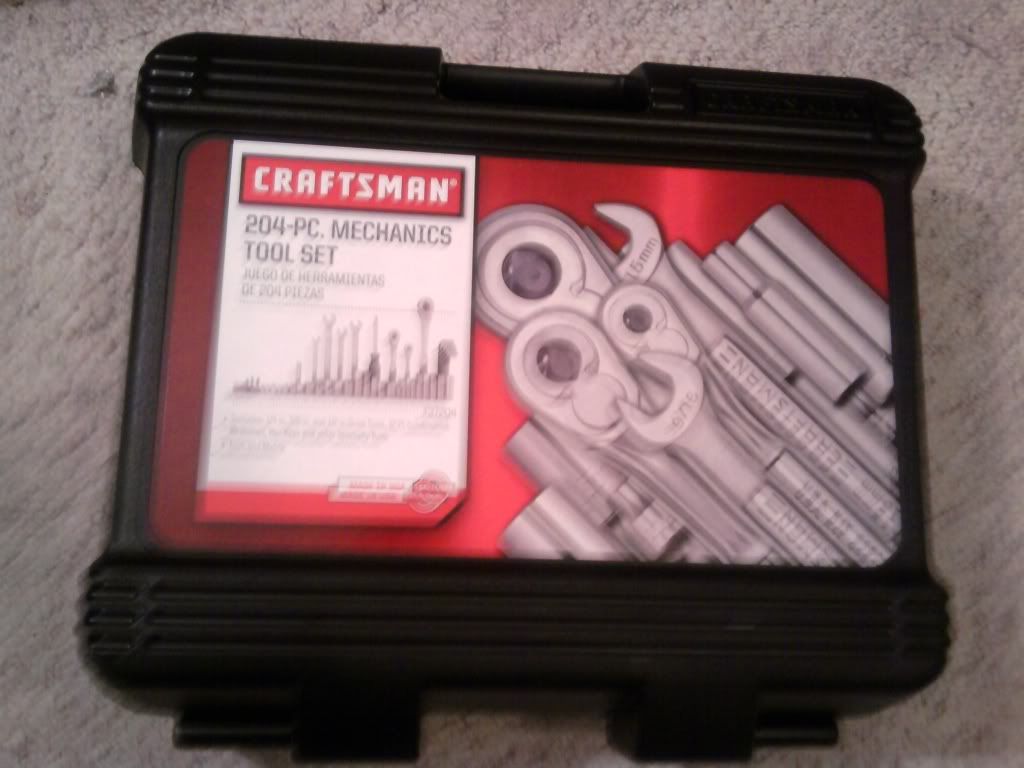You have a very good set to start with, similar to what I started with.
Here are some tools I found useful that you might want to add to your collection:
Get a universal in 3/8 and 1/2 from Sears. Get a set of different length wobble extensions in 1/4, 3/8, and 1/2 from Harbor Freight.
Get the small ratcheting philips and regular screwdriver bit set. It has a very small ratchet that the bit sticks through. I think Sears sell this but I purchased it several years ago so I am not sure.
Also you probably want a breaker bar in 1/2 inch drive. Another great tool like a breaker bar is a piece of pipe that fits over the handle of the ratchet and extends your leverage.
Look at the size of the sockets required to remove or install the alternator and work on or remove the belt tensioner for each vehicle you might end up working on. Some of them require large metric sockets you might want to have in your tool kit.
Make sure you have a socket for each spark plug size and also a spark-plug gap measuring tool. You probably want two spark plug sockets for each size, one with the rubber insert and one with-out. A feeler gauge set is the most accurate way to set a plug.
Get a small teeth per inch gauging set that fold up like feeler gauge set. And also get several bolt sizing devices.
Get some Loctite in the small bottle or small tube, get it in blue and high temp red. Loctite is a great product, learn to use it often. When you assemble a part with loctite vibration will not cause it to loosen, and it will require the same amount of torque to loosen it as was used to tighten it. The green Loctite is used to retain sleeves for cylinder liners, and valve guides. If you use it to assemble threaded parts you will probably have to break the part to get it apart.
Some other items you want:
tape measure,and a long reach parts grabber that uses little claws, and one that uses a magnet. A good hack saw (spend a few extra bucks for this one and get one with a very comfortable grip, you will have it for many years). Chanel lock pliers , long nose, and medium pliers, and a few different size vice grips.
If you are going to do front breaks you will have to get a very large C clamp to compress the wheel cylinder. Include a pencil and a pen along with a roll of masking tape. The masking tape can be used to label plug wires, and parts, and can be used to hold a bolt or nut to socket or to hold a screw to a screwdriver.
A set of adjustable wrenches of different sizes preferably with yellow rubber coated handles.
Get the larger set of SAE and Metric Allen Wrenches.
Get some Xcelite (with the black tip) Phillips screwdrivers. Be sure to get two of the Xcelite XST-102 Phillips screwdrivers. These Xcelite screwdrivers will last for decades and allow you to drive or remove philips screws where other screwdrivers will not work.
A impact driver with bits and a heavy mallet would be nice. A torque wrench would also be nice to have.
You will also want a Ryobi drill (from Home-Depot) and the large Titanium Nitride (looks like a gold color coating) set of drill bits that you can get at Harbor Freight.
You will want a trouble light (two trouble lights is even better) and probably want a creeper, thought a double layer of cardboard from a large appliance box can work almost as well and is almost as comfortable.
Get a can of PB Blaster rusted bolt penetrating oil. If you use this on a item in a house be sure to not allow over-spray, it will smell, not terrible but very noticeable.
Some 3M black electric tape and some wire cutters if you know how to work with electricity.
And a good flashlight will come in handy.
If you have a bench you will want a large vice, and a grinder on it.




